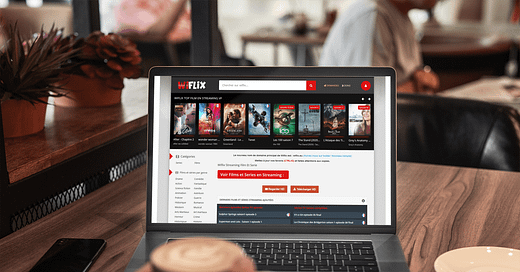Pulse54: Taking on the giants
Amid competition from big players, this local video streaming upstart is making its mark with affordable pricing, telco data bundling, and a focus on local content.
Hello folks! Welcome to another edition of Pulse54.
We know; it’s been a while since you heard from us.
But we apologize for going AWOL and are back for good! :))
Just a little refresher. Pulse54 is your first word on what’s old and new in Africa’s business and investment landscape - delivered twice a month.
If this email was forwarded to you, subscribe via the button below to get the next one directly in your inbox.
Now let's dive right into today’s topic.
Africa is considered the next big market for video streaming services like Netflix, Amazon Prime Video, and Disney+.
That’s because the continent has a huge population estimated at 1.3bn people.
More than 70% of Africans are also young (under age 30), and more people are getting access to the internet.
Also, Africa stands out as a truly mobile-first market. Leapfrogging traditional landline infrastructure, the continent went straight to mobile technology.
It is now the world's largest mobile-first economy.
For over 600m African internet users, smartphones are the primary source of entertainment. And up to 75% of the continent's internet traffic comes from mobile devices - the highest rate globally.
With smartphones capable of handling any type of content, it's no surprise that major video streaming platforms are vying to capture a slice of the rapidly growing market.
This confluence of a young, mobile-first population and increasing connectivity represents an enticing frontier, as we explain extensively in this edition of Pulse54.

And available data backs the viability of the market.
Digital TV Research projects subscriptions of video-on-demand in Africa to reach 15m by 2026, from 5m in 2021.
Industry revenues are poised to triple from $623m to $2bn over the same period.
But there’s a major roadblock—most Africans live on very little income.
Around 85% of people in sub-Saharan Africa live on less than $5.50 per day, which differs greatly from consumers in richer countries.
So streaming platforms need to change their usual strategies to fit the lower income levels of African viewers.
For instance, Netflix has tried to make its service more affordable in order to penetrate the market.
In September 2021, it launched a free, ad-supported plan until late 2023 in Kenya - the first country to get this worldwide.
The US giant also introduced cheaper mobile-only plans compared to its normal rates, a similar approach taken by Multichoice-owned Showmax.
Amid these efforts by well-funded players, local competitor Wi-flix prices even lower as part of a mix of strategies it adopts to capture low-income streaming viewers in Africa.
Wi-flix: Local Solution for Low-Income Streamers
Founded in 2020 by Louis Manu and Bright Yeboah, Wi-flix offers a meager $2.99 subscription fee, much cheaper than even Netflix's lowest $9.99 plan.
This low pricing targets Africans living on little income, making entertainment more affordable.
Costly internet can also stop people from streaming.
Africans have to pay between $50 and even $70 for a month of decent internet.
Shelling out an additional $10-$50 for streaming subscriptions is thus difficult for most.
So Wi-flix has partnered with mobile operators in Kenya, Ghana, and Nigeria.
Through these deals, its subscribers get discounted data bundles for streaming without using up all their data.
And like its global competitors, Wi-flix knows local content attracts viewers.
But it takes this further - 70% of its whole library is locally-made African shows and movies.
This emphasis on homegrown stories greatly appeals to African audiences.

Supporting Local Talent
Apart from its consumer strategies, Wi-flix is heavily investing in Africa's creative industry.
It operates a revenue-sharing model where creators earn based on how popular their work is - different from the usual lump-sum payments.
This incentivizes quality production and provides steady income for local talent.
Wi-flix has also set up a post-production studio in Ghana to enhance creators' content to meet international standards.
It plans to produce at least 100 original titles per year from this facility.
Wi-flix's methods saw it gain over 1 million paid subscriptions by over 300,000 customers within just a year of launching.
Currently, Wi-flix has:
1.2m+ customers and a rapidly growing user base
$28m+ projected 2026 EBITDA
Powerful distribution through Amazon and Foxxum deals
Visionary founders backed by elite investors
Preeminent gateway to 1bn+ African entertainment consumers
And the best part? You can be part of the ongoing streaming revolution in Africa as an investor in Wi-flix through Daba.
To capitalize on this opportunity, TAP HERE TO CONNECT with our team to discuss further and possibly secure an allocation before availability lapses.
The Streaming Battle for Africa: Who Wins?
The future of streaming in Africa promises to be highly competitive, with innovation around cultural representation and strategic partnerships.
Netflix and Showmax, seeing its global appeal, are investing more heavily in original African content.
As this streaming war intensifies, little-known platforms like Wi-flix - with its focus on African viewers' unique needs and preferences, especially the vast low-income segment - is well positioned to win in the long run.
But ultimately, African viewers may be the real winners, gaining access to a wide range of high-quality local content at prices aligned with their income levels.
Do you think Wi-flix will emerge as a market leader in the long run?
Let us know in the comments below.
You can also download the Daba app to access investment opportunities and get daily bite-sized insights into African economies and industries.
That's all for this week.
Until next time!



